It is important to train and build strong oblique and abs muscles to improve performance in exercise, sports, and everyday functional movements.
These standing abs exercises target not only the abs muscle but also help stimulate the core—including the oblique, back, and glutes—to help you sculpt, tone, and strengthen the abs and obliques.
Unlike the usual mat moves, standing exercises are functional exercises. They work with your natural body movements to mimic how you use your muscles in real life, like carrying groceries, mowing the lawn, or deep cleaning the bathroom.
These 15 standing oblique and abs exercises are scalable from beginner to advanced (you can intensify them by adding weights).
So, what are the best abs exercises you can do while standing up? Keep reading to find out.
Use our free calculator to know your weight loss calories requirement.
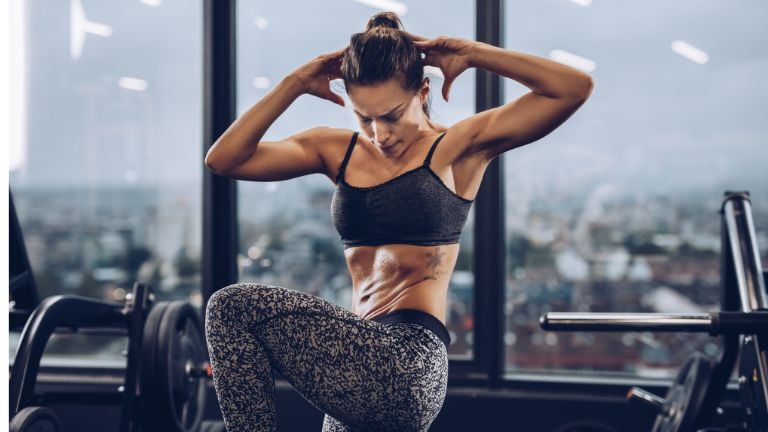
- Best Standing Abs Exercises
- 1. Inchworm
- 2. High Knee
- 3. Standing Oblique Twist
- 4. Pallof Press
- 5. Landmine Twist
- 6. Jumping Jack
- 7. Standing Machine Twist
- 8. Dumbbell Side Bend
- 9. Standing Barbell Twist
- 10. Standing Oblique Crunch
- 11. Cable Wood Chop
- 12. Standing Cable Crunch
- 13. Standing Side Leg Raise
- 14. Dumbbell Lunges With Twist
- 15. Cable Twist
- Standing Abs and Oblique Workout Plans
- References
Best Standing Abs Exercises
If you’re looking to build toned abs, it can be beneficial to incorporate standing oblique exercises into your workout routine.
Here are the 15 best standing exercises to help you build a strong abs and oblique muscle.
1. Inchworm
The inchworm is a total-bodyweight workout requiring minimal equipment and space. This full-body movement is an effective exercise to include in a warm-up routine, a training circuit, or a high-intensity interval training routine.
Inchworms are a great ab exercise for beginners and don’t require any equipment. They also improve flexibility in your hamstrings and build strength in your shoulders, chest, and core.
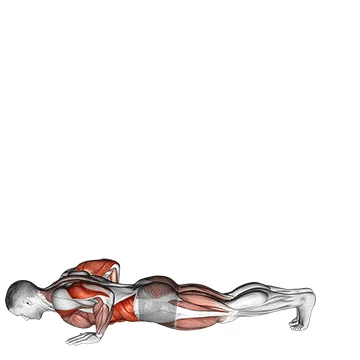
How To Do Inchworm
- Stand with feet hip-width apart, maintaining good posture.
- Inhale, then exhale as you roll down, reaching your hands toward the floor.
- Slightly bend your knees to allow your hands to touch the ground.
- Walk your hands forward into a full plank position.
- Ensure your body is in a straight line from heels to head, engaging core, chest, quads, triceps, and shoulders.
- Walk your feet forward toward your hands, stretching your hamstrings and glutes.
- Roll up slowly to standing, straightening your spine one vertebra at a time.
- Repeat for time or repetitions.
2. High Knee
High Knee is an excellent cardiovascular exercise that is popularly practiced worldwide. This exercise might look easy to perform, but is a challenging move that targets multiple muscle groups in the body.
It recruits the abs and core muscles greatly, and eventually, this will make it more effective to build six pack abs. You don’t require any special tool or equipment to perform it, and therefore it is the best 6 pack home workout.
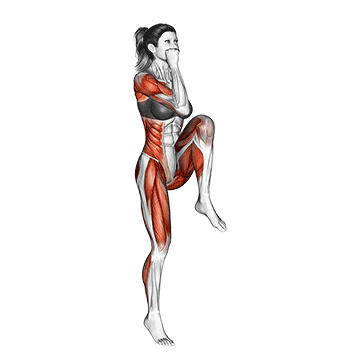
How To Do High Knee
- Start standing with feet hip-distance apart.
- Lift the right knee as high as it will go and raise the opposite arm, then switch quickly, so the left knee is up before the right foot lands.
- Continue pulling knees-up quirky for as long as desired.
- Make sure to keep breathing.
- It is a great warm-up or full-body exercise that prepares your body for harder core exercises.
3. Standing Oblique Twist
Standing Oblique Twists (also known as standing twists, side twists, or oblique twists) is a dynamic standing oblique exercise.
This oblique exercise will help develop a functional core and a well-looking midsection.
Don’t underestimate the benefit of these standing oblique and abs exercises. Ensure that you’re twisting your whole torso, not just your arms, to get the full benefit.
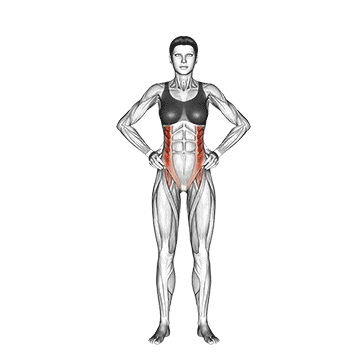
How To Do Standing Oblique Twists
- Stand with your feet hip-width apart, and bring your arms to your chest.
- Brace your core and begin to twist your upper body to the left side of your body, then the right.
- Keep your body still during the motion; only your torso moves.
- Exhale on the turns, and inhale when coming back.
- Repeat until all reps have been completed.
4. Pallof Press
If you’re looking for a way to get more creative with standing abs and oblique exercises, why not try Pallof Press?
It is a full-body exercise that can increase overall stability and activate many large muscle groups in the body.
The beauty of the Pallof press is that it challenges and strengthens the stabilization action of your oblique and abs.
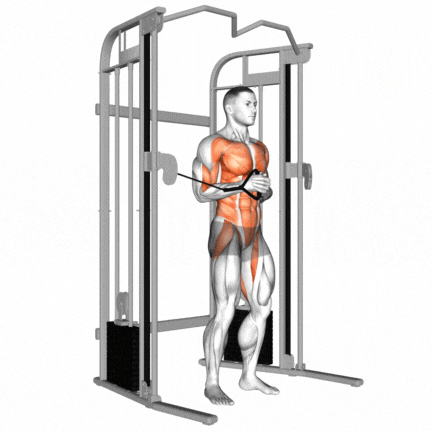
How To Do Pallof Press
- Attach a handle to a chest-high cable pulley. Stand on the side cable machine with your feet hip-width apart.
- Grasp the handle with the hand nearest the pulley, pull the handle to your chest, and place your free hand over the hand holding the handle.
- Engage your core and press the handle out with both hands, so your arms are extended in front of your chest.
- Hold this position, resisting the pull of the cable and not letting your torso rotate towards the machine, for five to ten seconds then bring the handle back in to your chest.
- Repeat the exercise on your opposite side.
Know More: 18 Abs Exercises At Home Without Equipment
5. Landmine Twist
The landmine twist is a rotational abdominal movement performed using an angled barbell anchored at floor level in a landmine device.
It targets the deep muscles of the core, including both the obliques and the transversus abdominis.
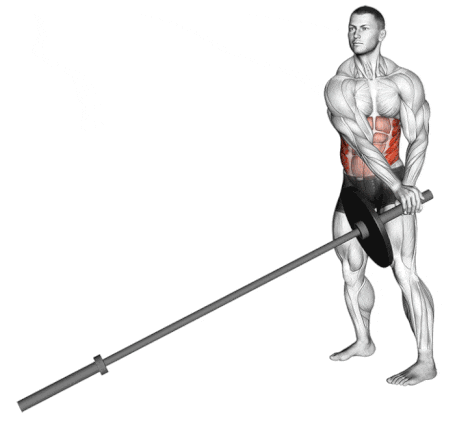
How To Do Landmine Twist
- Position a bar into a landmine or securely anchor it in a corner. Load the bar to an appropriate weight.
- Raise the bar off the floor, taking it to shoulder height with both hands with your arms extended in front of you. Adopt a wide stance.
- Keep your knees bent as you rotate. This should help relieve some tension in your lumbar spine.
- Rotate the trunk and hips as you swing the weight all the way down to one side. Keep your arms extended throughout the exercise.
- Reverse the motion to swing the weight all the way to the opposite side.
6. Jumping Jack
Jumping jacks are an efficient total-body workout that you can do almost anywhere. This exercise is part of what’s called plyometrics, or jump training. Jumping jacks also involve your abdominal and shoulder muscles.
Jumping Jacks are a great full body exercise that enhances aerobic fitness, strengthens the body, and promotes relaxation. This exercise also improves muscle endurance, increases the body’s metabolic rate, and helps with weight loss and 6 pack abs.
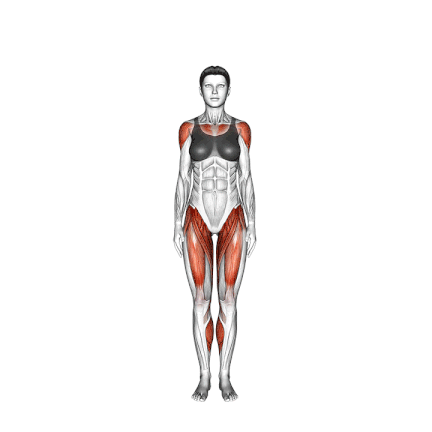
How To Do Jumping Jacks
- Stand straight with your feet together and hands by your sides.
- Jump up, spread your feet and bring both hands together above your head.
- Jump again and return to the starting position.
- Repeat until the set is complete.
- So, this is the last exercise, guys. Push it as hard as you can.
- Keep the knees slightly bent and land softly on the balls of your feet.
7. Standing Machine Twist
It is feasible to easily perform this standing oblique twist exercise on a twisting machine.
It strengthens your core, so they may help you avoid back injury. A strong core is also important for physical strength and balance.

How To Do Standing Machine Twist
- Stand on a twist machine with feet hips apart and hold the machine handles.
- Assume a normal posture, with your back straight.
- Exhale and, using your abdominal muscles, twist the pelvis slowly to your right, as far as you can, tensing your abs.
- Hold the stretch for several seconds and return to your starting position while inhaling.
- Perform the stretch on the other side, this time turning to your left as far as you can without moving your head and upper torso
8. Dumbbell Side Bend
The dumbbell side bend is effective at targeting the internal and external obliques, strengthening the lateral flexion of your spine, improving spinal mobility, and helping to develop a strong and stable core.
It is an easy oblique exercise to practice at home in a standing position. If you’re new to the exercise, practice the movement with your bodyweight alone.
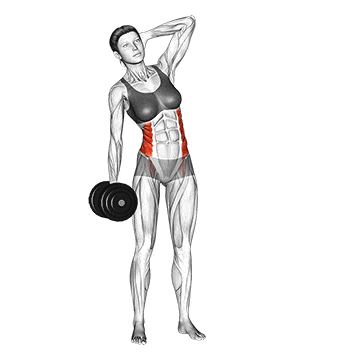
How To Do Standing Dumbbell Side Bend
- Stand with your feet shoulder-width apart while holding a dumbbell with a neutral grip in your right hand with your arm hanging at your side. You can place your free hand behind your head.
- Keep the dumbbell close to your side, your elbow slightly bent, and your hips still.
- Bend sideways at the waist to the left as low as possible, using your oblique muscles to pull your torso down.
- Keep your back straight, eyes facing forward, and bend at the torso only.
- Hold for a second and return to the starting position.
- Complete the desired number of reps and repeat on the other side.
Known Your Body Fat %: Try Free Calculator To Know Your Body Fat Percentage
9. Standing Barbell Twist
The standing barbell twist focuses on your obliques. Use the barbell twist to strengthen the twisting movement pattern of your body.
It is a great idea to stop halfway through some reps, and attempt to resist the twisting force.
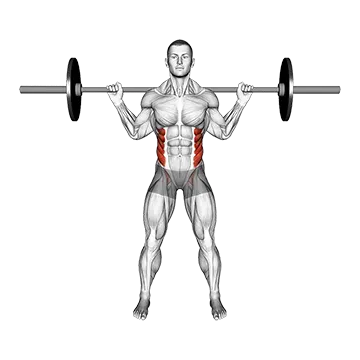
How To Do Standing Barbell Twist
- Grab a light barbell and rest it on your upper back. Do not rest the weight on your neck.
- Stand up straight, with your feet firmly on the floor at a wider than shoulder width stance, keeping your back straight.
- Slowly twist your torso to the right and then to the left. Tense up your mid-section.
- Keep the movement slow and under full control. Do not allow momentum to build up, as this can hurt your spine.
- Try to keep your abs tight throughout the whole set.
10. Standing Oblique Crunch
Standing oblique crunches, also popular as side crunches, are effective abdominal exercises that target your oblique muscles and are performed by assuming a standing position.
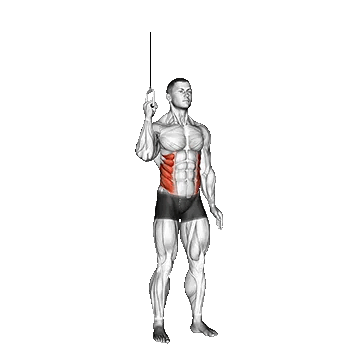
How To Do Standing Oblique Crunches
- Attached D-handle to a high pulley and stand side-on to the weight stack.
- Grasp the D-handle with your left hand and stand with the pulley to your left side.
- Make sure your forearm is positioned at a 90-degree angle to the upper arm and your feet are firmly placed on the floor at shoulder width.
- Keep your head up and back straight, and pull the weight down using your left oblique muscle as much as possible.
- Pause for a second and then return to the initial position.
- Repeat for the desired number of repetitions. Turn around and repeat the cable side bend with your left side.
11. Cable Wood Chop
The cable wood chop, also known as the cable up-down twist, is great for strengthening the torso’s twisting movement pattern and improving its ability to resist twisting forces.
You can do wood chops with a medicine ball or dumbbell, but the cable provides a constant tension, which is preferable.
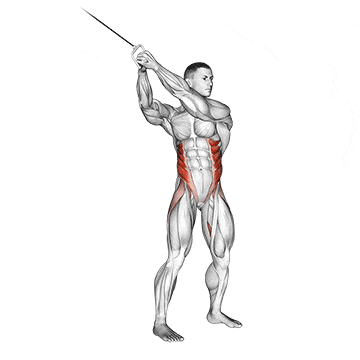
How To Do Cable Wood Chop
- Attach a handle to the top of the cable pulley.
- Grasp the handle with both hands, with either your fingers interlaced or with one hand over the other. Stand next to the machine with your feet shoulder-width apart.
- Keeping your arms straight, pull the handle diagonally downward until your torso faces away from the pulley and your hands are knee-height.
- Hold for a count of two. Then, slowly reverse the movement to return to the starting position.
- Repeat for the prescribed number of repetitions. Repeat the exercise on your opposite side.
Know More: 21 Best Oblique Exercises For A Strong Core
12. Standing Cable Crunch
Since you’re standing while doing a crunch, your core has to work harder to stay stable against the cable’s pull. This means your abs, obliques, and deeper core muscles (like the transverse abdominis) get in on the action, too.
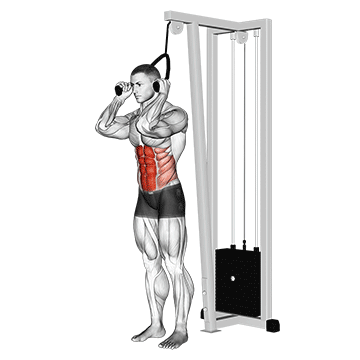
How To Do Standing Cable Crunch
- Attach a rope to a high pulley and choose the right weight.
- Stand with your back to the cable tower. Hold the rope to your upper chest with both hands over your shoulders. This will be your starting position.
- Perform the movement by flexing the spine and crunching the weight down as far as possible.
- Hold the peak contraction for a moment before returning to the starting position.
13. Standing Side Leg Raise
This is a winner if you’re not big on jumping around or putting stress on your joints. You’re working your core without all the pounding.
You’re standing on one leg while lifting the other, so your core must work overtime to keep you steady. It’s like a secret ab workout disguised as a leg exercise.
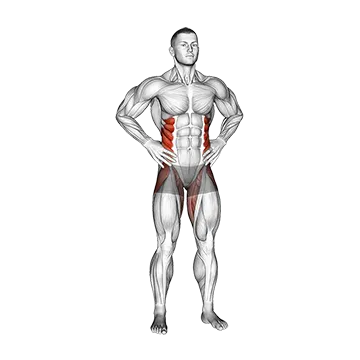
How To Do Standing Side Leg Raise
- Stand up straight with your feet hip-width apart and your arms at your sides.
- Shift your weight onto your left foot and lift your right foot off the ground, keeping your leg straight.
- Slowly raise your right leg out to the side, keeping it straight and your toes pointing forward.
- Pause for a moment when your leg is at hip height.
- Lower your leg back down to the starting position.
- Repeat the exercise on the other side, shifting your weight onto your right foot and lifting your left leg.
- Complete 10–15 repetitions on each side.
14. Dumbbell Lunges With Twist
Dumbbell Lunges with a twist is an excellent exercise to build thigh muscles and glutes, abs, and oblique.
However, this exercise requires good balance, so if you have issues keeping your balance, start off by doing the lunges twist exercise without weights as you learn the proper form.

How To Do Dumbbell Lunges With Twist
- Stand with your feet shoulder-width apart. With both hands, hold one dumbbell at your chest, gripping it on each end.
- Our chest should be upright and your torso should be leaning slightly forward so that your back is flat and not arched or rounded forward.
- Step forward, bending your knees, to create two 90-degree angles with your legs.
- Slowly rotate your torso to the left. You should feel a nice stretch in your midback.
- Push yourself back to the starting position and repeat with the other foot.
- Keep alternating the leg with which you lunge twist
15. Cable Twist
Finally, try the cable twist if you’re looking for one more effective standing oblique exercise.
The cable twist is an isolation exercise that works the oblique muscles of the core. It strengthens the body’s twisting movement pattern.
It is a great idea to stop halfway through some reps, hold the stirrup, and try to resist the twisting force. This will strengthen your torso’s ability to resist twisting forces.
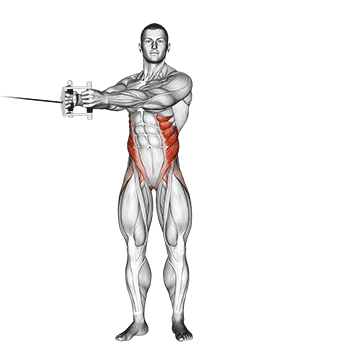
How To Do Cable Twist
- Attach a handle to a shoulder-height cable pulley. Hold on to the handle with both hands, either with your fingers or with one hand over the other.
- Keep your arms straight and pull the handle in a twisting motion across your body to the opposite side until your body is away from the pulley.
- Hold for a count of two. Then slowly reverse the movement to return to the starting position.
- Repeat the prescribed number of times. Repeat the exercise on your opposite side.
Standing Abs and Oblique Workout Plans
| Day | Workout Plan |
|---|---|
| Monday | Warm-up: 10-minute brisk walk or light jogging. Standing Abs Exercises: – High Knee: 3 sets of 15 reps per side. – Pallof Press: 3 sets of 12 reps per side. Cardio: 20 minutes steady-state (cycling or elliptical). |
| Tuesday | Warm-up: 10-minute dynamic stretching. Strength Training: Lower Body (e.g., squats, lunges, deadlifts). Finisher: 5-minute Standing Mountain Climbers. |
| Wednesday | Rest or Active Recovery (yoga, swimming, or light walk). |
| Thursday | Warm-up: 10-minute brisk walk or light jogging. Standing Obliques Exercises: – Standing Twist: 3 sets of 12 reps per side. – Dumbbell Side Bend: 3 sets of 15 reps per side. HIIT: 15 minutes (30 sec on, 30 sec off). |
| Friday | Warm-up: 10-minute dynamic stretching. Strength Training: Upper Body (e.g., push-ups, rows, shoulder press). Finisher: 5-minute High Knees. |
| Saturday | Full-body Workout: Combine strength, cardio, and standing abs exercises. |
| Sunday | Rest Day or Active Recovery (optional). |
References
- Clark AW, et al. (2017). Effects of pelvic and core strength training on high school cross-country race times.
https://pubmed.ncbi.nlm.nih.gov/27893484/ - Nicks R. (2022). Personal interview.
- Rosemeyer JR, et al. (2015). Effects of core-musculature fatigue on maximal shoulder strength.
https://pubmed.ncbi.nlm.nih.gov/25658299/

Manish is a NASM-certified fitness and nutrition coach with over 10 years of experience in weight lifting and fat loss fitness coaching. He specializes in gym-based training and has a lot of knowledge about exercise, lifting technique, biomechanics, and more.
Through “Fit Life Regime,” he generously shares the insights he’s gained over a decade in the field. His goal is to equip others with the knowledge to start their own fitness journey.
